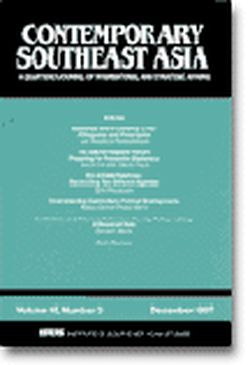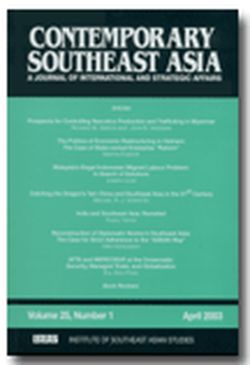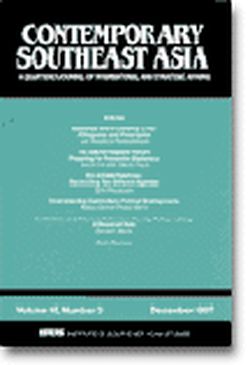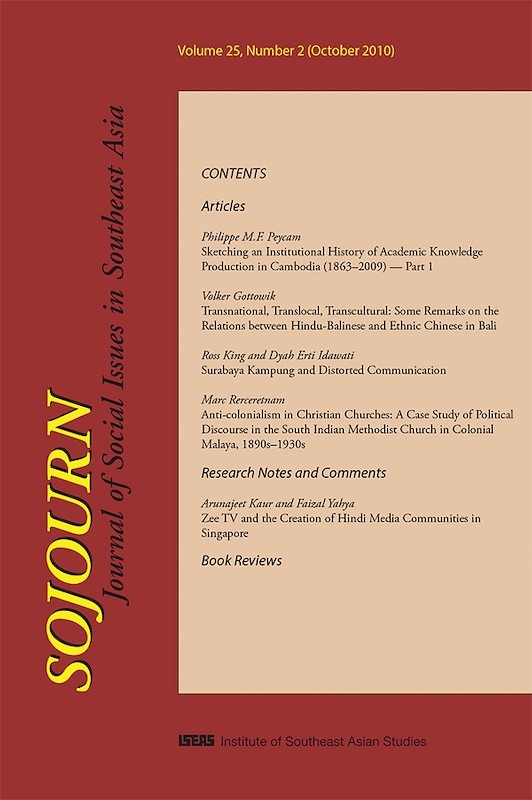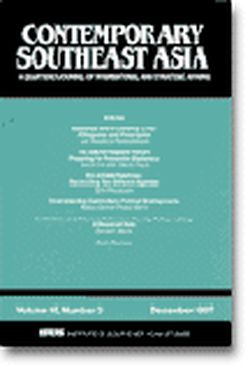Contemporary Southeast Asia: A Journal of International and Strategic Affairs Vol. 16/2 (Sept 1994)
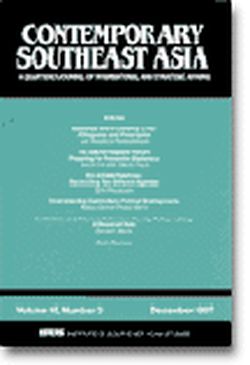
Date of publication:
September 1994
Number of pages:
124
Code:
CS16/2
Contents
-
Preliminary pages
- ARTICLES
-
The ASEAN Regional Forum: The Spirit of Constructive Engagement, by Michael Antolik, author see abstractThe ASEAN states have taken a central role in an East Asian security regime. Rather than focus on problem-solving or negotiations, the ASEAN Regional Forum (ARF} stands as a consultative process to further the benefits of constructive engagement: economic development and stability. Its formation recalls ASEAN's own cautious concern for building consensus and bilateral understandings in preparation for a multilateral endeavour. ASEAN-like, states are called upon to practice self-restraint, by renouncing force and interference in other states' domestic affairs. Moreover, to achieve regional stability through a balance of great powers, the ASEAN states have often facilitated inclusion of all through an informal diplomacy that limits obligations and protocol.
-
Sino-Indian Rivalry in Myanmar: Implications for Regional Security, by J Mohan Malik, author see abstractDespite significant improvement in bilateral relations between India and China, a geopolitical rivalry for influence and dominance in past-Cold War Asia is intensifying between the two Asian giants. Nowhere is this contest for regional hegemony between China and India more evident than in Myanmar which occupies a critical strategic position between the two countries. China's inroads into Myanmar since 1990, especially the build-up of naval facilities in the Bay of Bengal and its possible use by the Chinese military, are, from New Delhi's perspective, serious encroachments into India's sphere of influence. Indian strategists now see China as constituting a threat in the east as well as in the north. The growing military nexus between China and Myanmar has recently prompted the Indian Government to reassess its policy towards Yangon and to emphasize the complementarity of interests between Indian and the United States, India and ASEAN, and India and Japan, in containing China's growing economic and military influence in the Asia-Pacific. India's determination to develop a degree of regional dominance comparable with China means that early in the next century. New Delhi might slip into the role of the main counterweight to its gaint neighbour. Both India and China will continue to monitor closely each other's activities to expand influence and gain advantage in the wider Asian region and will attempt to fill any perceived power vacuum or block the other from doing so.
-
The State, Civil Society, and Foreign Actors: The Politics of Philippine Industrialization, by Temario C Rivera, author see abstractIn the Philippines, the politics of the industrialization process is best understood by examining the process of collaboration and contestation that have marked the relationship among three key actors: a weak state, powerful elites in civil society, and influential foreign actors. Unlike the insulated developmentalist states of East Asia and the relatively stronger states of ASEAN, the Philippine state has been a captive of powerful vested interests. Among the dominant actors of civil society, the landed capitalists have shown an extraordinary resilience by diversifying their bases of wealth, enabling them to dominate the manufacturing class nurtured by the import-substitution industrialization (ISI) period. During this period, foreign investment and joint-venture arrangements strengthened an inward-looking market orientation that made the shift to export orientation more difficult. To sustain industrial growth and development, the state should construct and support a "growth coalition" of key social actors.
-
An Analysis of Sino-British Negotiations Over Hongkong's Political Reform, by Lo Shiu-Hing , author see abstractThe Sino-British debate over Governor Chirstopher Pattenr's reforms has Illustrated fundamental differences in the pace and degreeof Hong Kong's political reform, the extent of elite and mass participation, the meaning of the agreements reached between China and Britain, the style of policy-making in Hong Kong, and the power relations between Hong Kong's executive and legislative branches. Although the British have succeeded in protecting an image of standing up for fair and open election in Hong Kong, their failure toi reach an agreement with China wil result in a backlash 3-giving more room ot the Chinease side to shape, control and recolonize aspects of Hong Kong's polity after 1997. While Patten's reform package was endorsed by Hong Kong's legislature in June 1994, such endorsement probably marks the temporary and short-lived nature of democratization in the last British colony in Asia from now to 1997.
-
The Ethnic Vietnamese in Cambodia: A Minority at Risk?, by Ramses Amer, author see abstractThis article deals with the situation of the ethnic Vietnamese in Cambodia, and the attitudes and policies of the Cambodian authorities towards that minority. Patterns of Vietnamese migration to and from Cambodia are studied with the aim of identifying the dynamics behind them. As anti-Vietnamese sentiments have been regularly displayed by the Cambodian elite and in the policies of the Cambodian authorities, the roots and effects of these attitudes are explored. The anti-Vietnamese discourse in Cambodia shows that the perceptions of Vietnam as a neighbouring state influences the attitudes towards the Vietnamese minority. Discriminatory policies implemented by the Cambodian authorities and attacks instigated by such policies had led to the virtual elimination of the Vietnamese minority in the 1970s, when some 420,000 Vietnamese were expelled or fled to Vietnam. Seen in this perspective, the repeated politically motivated attacks on ethnic Vietnamese in recent years present a real threat to the Vietnamese community at large.
- BOOK REVIEWS
-
BOOK REVIEW: India's Foreign Policy 1947-92: Shadows and Substance by Harish Kapur, by Kripa Sridharan, author

